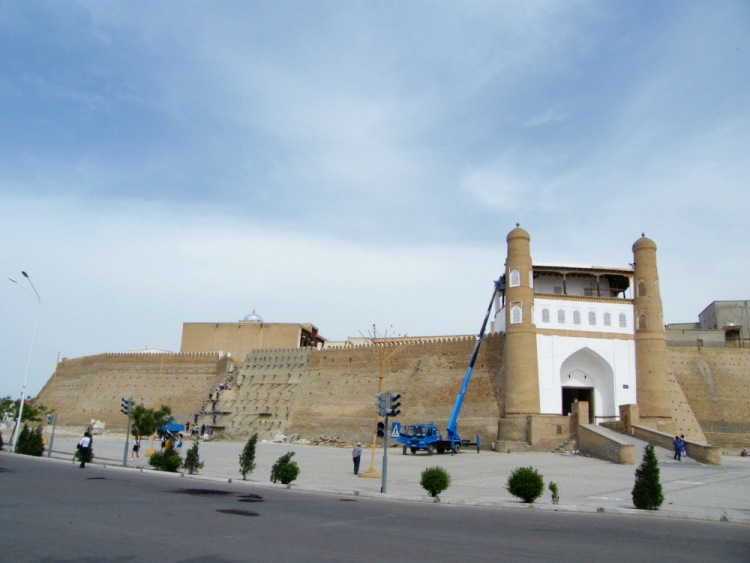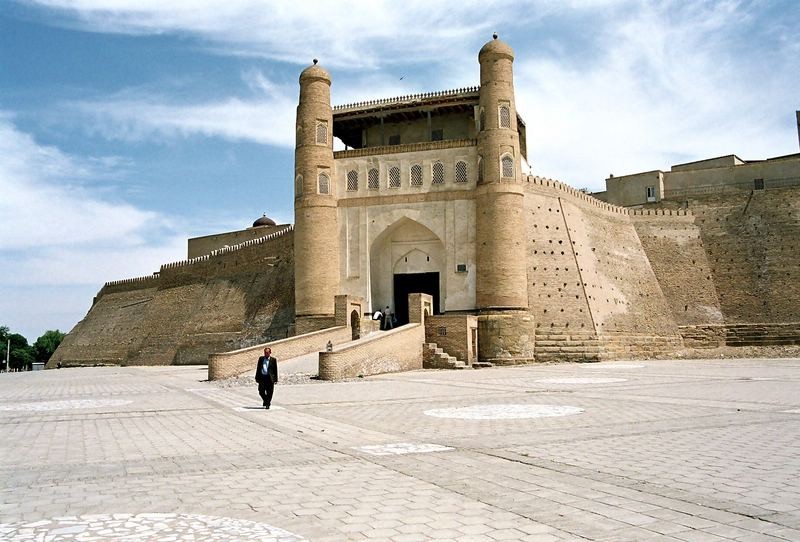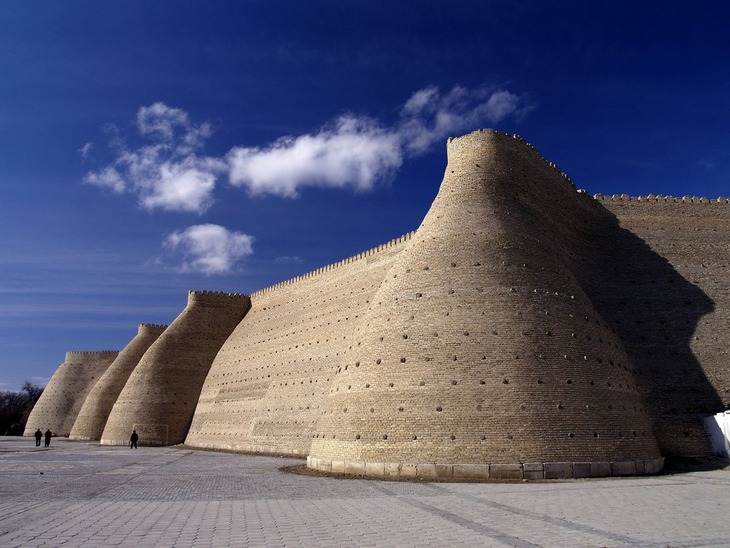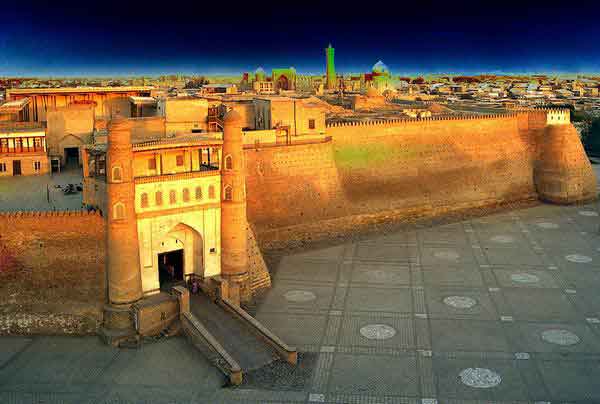The Ark of Bukhara is a massive fortress located in the city of Bukhara, Uzbekistan that was initially built and occupied around the 5th century AD. In addition to being a military structure, the Ark encompassed what was essentially a town that, during much of the fortress' history, was inhabited by the various royal courts that held sway over the region surrounding Bukhara. The Ark was used as a fortress until it fell to Russia in 1920. Currently, the Ark is a tourist attraction and houses museums covering its history.
Description
The Ark is a large earthen fortification located in the northwestern part of contemporary Bukhara. In layout it resembles a modified rectangle, a little elongated from the west to the east. The perimeter of the external walls is 789.6 metres (2,591 ft), the area enclosed being 3.96 hectares (9.8 acres). The height of the walls varies from 16 to 20 metres (52 to 66 ft).
Entrance to the Ark fortress.
The ceremonial entrance into the citadel is architecturally framed by two 18th Century towers. The upper parts of the towers are connected by a gallery, rooms, and terraces. A gradually rising ramp leads through a winch-raised portal and a covered long corridor to the mosque of Dzhuma. The covered corridor offers access to storerooms and prison cells. In the center of the Ark is located a large complex of buildings, one of the best preserved being the mosque of Ul'dukhtaron, which is connected to legends of forty girls tortured and cast into a well.
Legendary origin
In legend, the creator of the Ark was the epic hero Siyavusha. As a youth, he hid in the rich oasis country of Turana from his stepmother. Siyavusha and the daughter of the local ruler of Afrosiaba fell in love. The girl's father agreed to permit them to marry provided that Siyavusha would first build a palace on the area bounded by a bull skin, obviously intended as an impossible task. But Siyavusha cut the bull skin into slender strips, connected the ends, and inside this boundary built the palace. (This is essentially the classical legend of Dido and the founding of Carthage in North Africa, as recorded in antiquity.)
History
The Ark is built on the remains of earlier structures, which constitute a layer twenty meters deep under the base arch, the layers indicating that previous fortresses had been built and destroyed on the site.
The first known reference to the Ark is contained in the "History of Bukhara" by Abubakra of Narshakhi (899 - 960). Abubakra wrote "Biden, the ruler of Bukhara, built this fortress, but it soon was destroyed. Many times it was constructed, many times destroyed." Abubakra says that when the last ruler to rebuild asked counsel of his wise men, they advised him to construct the fortress around seven points, located in the same relation to each other as the stars of the constellation Ursa Major. Thus built, the fortress was never again destroyed.
The age of the Ark has not been established accurately, but by 500 AD it was already the residence of local rulers. Here, in the fastness of the citadel, lived the emirs, their chief viziers, military leaders, and numerous servants.
When the soldiers of Genghis Khan took Bukhara, the inhabitants of the city found refuge in the Ark, but the conquerors smashed the defenders and ransacked the fortress.
In the Middle Ages the fortress was worked on by Rudaki, Ferdowsi, Avicenna, Farabi, and later Omar Khayyám. Here also was kept a great library, of which Avicenna wrote:
“ I found in this library such books, about which I had not known and which I had never before seen in my life. I read them, and I came to know each scientist and each science. Before me lay gates of inspiration into great depths of knowledge which I had not surmised to exist. ”
Most probably, the library was destroyed following one of the conquests of Bukhara.
During the Russian Civil War, the Ark was greatly damaged by Red Army troops under the command of Mikhail Frunze during the 1920 Battle of Bukhara. Frunze ordered the Ark bombed by aircraft, which left a large part of the structure in ruins. There is also reason to believe that the last Emir, Alim Khan (1880–1944), who escaped to Afghanistan with the royal treasury, ordered the Ark to be blown up so that its secret places (especially the harem) could not be desecrated by the Bolsheviks. And in fact the harem building did suffer great damage, being reduced to rubble to the extent that archaeologists have pronounced it incapable of restoration.













